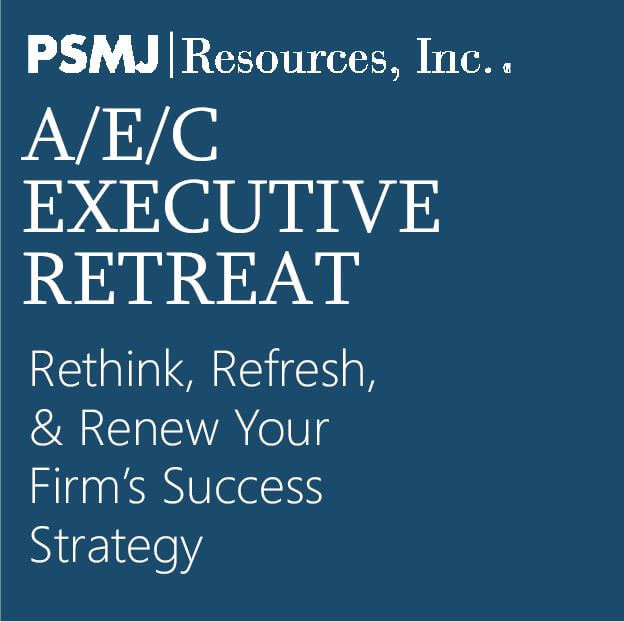What a year it has been. Beyond the obvious pandemic-related impacts, infrastructure spending, artificial intelligence, and private equity are just some of the terms you have probably heard more and more mention of this year. How could these forces drive disruption and create opportunity in your firm?
One such opportunity going into 2022 may be growth through acquisition. While the M&A market is quite active now and valuations are climbing as a result, this is still a great time for the right strategic buyers to use M&A as an avenue to achieve long-term sustainable growth. But, a big mistake that we see too many A/E firm leaders making on the M&A front is venturing into the market without the right tools and insights for success. For starters, when it comes to M&A, the strategy comes before the transaction…not the other way around.
Sound M&A strategy starts with a sound strategic plan…and high quality sellers find a solid plan to be extremely attractive. With this being the season for strategic planning, we’ve got some tips for getting it right before you go jumping head-first into any M&A plans. So many strategic planning sessions go badly due to poor organization and meetings that veer off of the agenda. Discussions can become mired in day-to-day operational detail instead of focusing on the long term. Thorough preparation is key to avoiding these problems and building an efficient and productive planning session. To this end, following are four tips for effective strategic planning:
1. Get away. Schedule your two to three planning days at a comfortable, quiet place away from the office. You can’t concentrate on planning for the future when reminders of your day-to-day responsibilities surround you. As an aside, there really is no substitute for face-to-face interaction on these deep and complex issues.
Tell others not to contact you unless there is a dire emergency (if your firm can’t run without its leadership team for a couple of days, you should probably be addressing leadership issues as part of your strategic plan).
2. Bring data. You’ll need data when you discuss your strengths and weaknesses. Otherwise, the discussion will bog down with anecdotal evidence, which doesn’t provide you with the numbers you’ll need to set measurable goals.
At the same time, it is important not to get loaded down with too much data. Software dashboards make it easy to collect lots of numbers, but numbers don’t equal knowledge or understanding. Decide what types of data are important for your own firm, your current situation, and your future.
3. What Makes a Good Meeting? Your planning time is valuable: don’t waste a minute of it. Give some attention in advance to each of the following factors. These factors will make your meeting productive:
• The right people and only the right people
• Clearly defined purpose and desired outcomes
• A good facilitator
• A time and place conducive to create thought
• An agenda devised with your facilitator and sent to participants before the meeting
• Adhering to the agenda—revise it only with a consensus of the participants • Specified starting times, ending times and break times
• Clearly defined roles that people know in advance
• Self-discipline on the part of participants to adhere to the purpose and the agenda
• Time allotted to defining next steps and who is responsible for them, and scheduling next meetings
4. The right environment. The following are ground rules developed over the years by PSMJ to assure that all meeting participants understand how they are expected to behave. Each participant should agree to these before starting the meeting:
1. All participants are expected to express their opinions openly and honestly. 2. You have an obligation to speak up if you disagree.
3. No one will be criticized for voicing and honest opinion.
4. Self-serving comments are OK, if they are properly identified as such.
5. Objective is to reach consensus, defined as follows:
o a. the majority is in favor.
o b. those opposed are willing to support the decision. 6. All discussions will remain strictly confidential.
7. Make sure the sessions start on time. Anyone arriving in meeting room after any scheduled start time will pay a $1 late fee
If you (or one of the other firm leaders on your team) have decided that this is the year to get started on an acquisition or a firm sale, get off on the right foot. It may be tempting to get right into the thick of negotiations and dealmaking, but time spent in the initial strategic planning phase (well before any specific transaction is under review) will be time well spent and will provide a much-needed framework for evaluating a potential transaction and their ability to bring the firm closer to its strategic objectives.
 |
Register for PSMJ's A/E/C Executive Retreat April 18-21, 2022 in Sonoma, California. The ONLY facilitated forum for A/E/C peer executives to share and assess new strategies to capitalize on change and achieve new levels of success. Click to learn more. |


